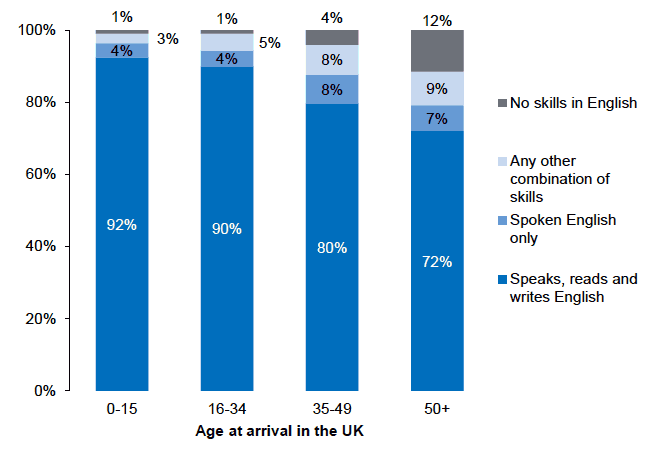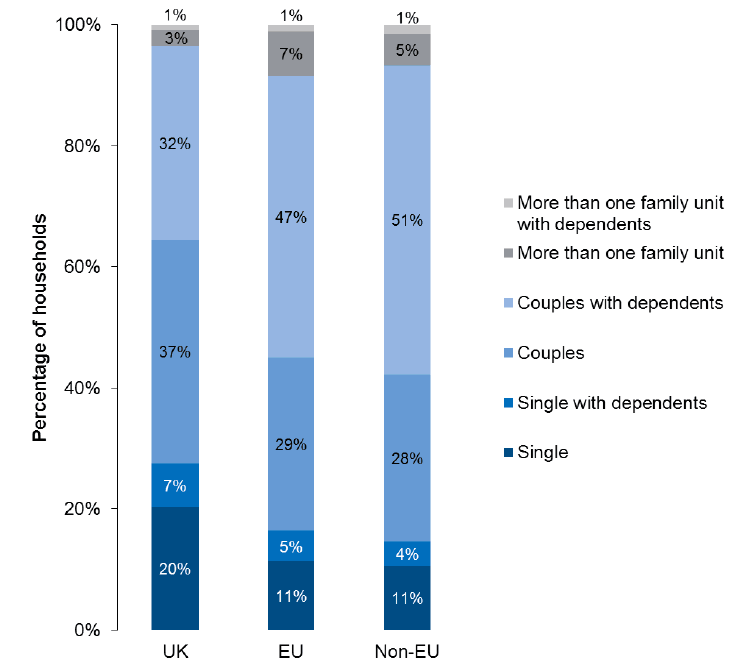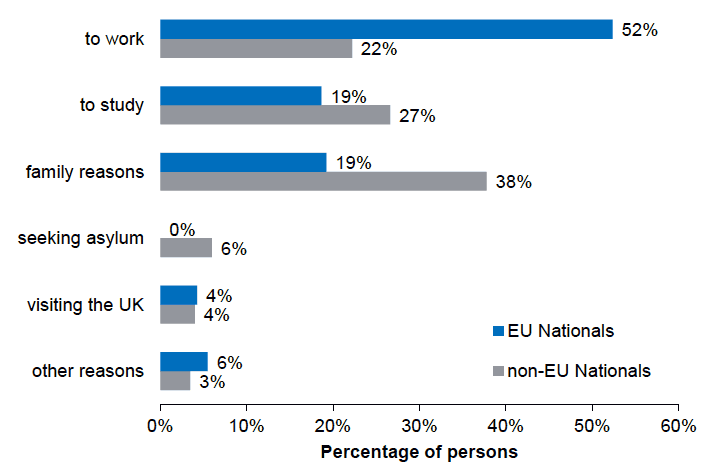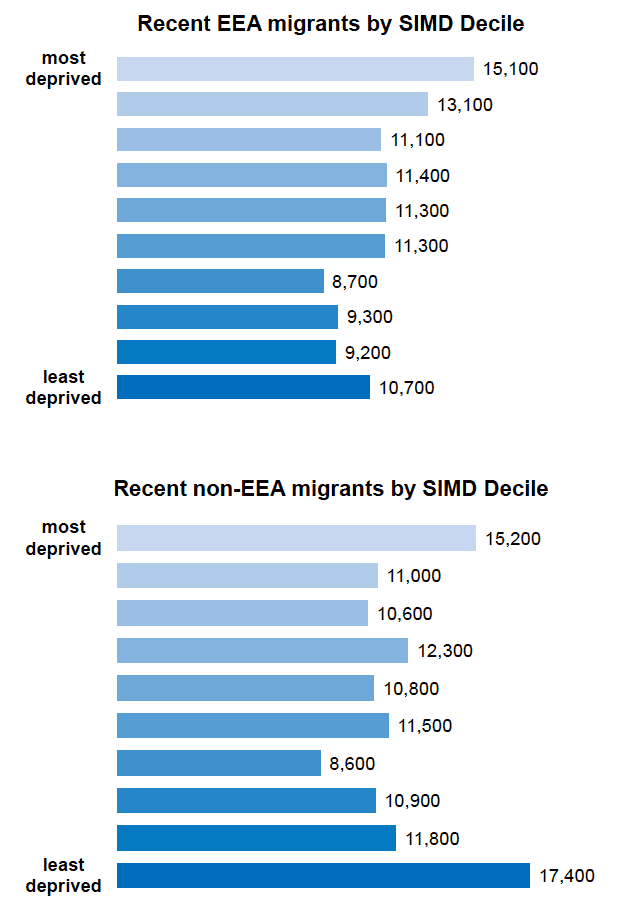The contribution of EEA citizens to Scotland: response to the Migration Advisory Committee call for evidence - evidence annex
The Evidence Annex sets out the main elements of the most robust date we have on migrants and migration in Scotland.
Chapter 3 – Economic, social and fiscal impacts
Key insights
- EU migrants have a positive effect on the Scottish economy: each EU migrant working in Scotland contributes an additional £34,400 to GDP per year. The total contribution by EU citizens working in Scotland is approximately £4.42 billion per year.
- Scotland is becoming an increasingly diverse country, with almost one in ten of the population born outside the UK.
- Almost all migrants coming to live and work in Scotland have proficient English language skills. Migrants also bring a range of different languages to Scotland.
- Migrants are more likely than UK nationals to be living as couples with dependents, and less likely to be in single person households.
- More than 70% of EU migrants and almost half of non- EU nationals living in Scotland came to work or study.
- Economic migrants are generally young, with low healthcare needs.
- The majority of recent migrants live in the private rental sector; however, after ten years in Scotland more than 70% own their homes.
- Recent non- EEA migrants are more likely to live in the most and least deprived areas, while higher proportions of recent EEA migrants are in the six most deprived deciles than in the four least deprived.
- Higher costs of education provision for migrants are associated with translation and interpreting services, numeracy and literacy of young children who have not received a formal education, understanding of cultural differences by staff, and lack of records and assessment.
- The relationship between the number of migrants in schools and performance is not clear, although there is evidence that school performance and pupil achievement are positively correlated with the presence of pupils with English as an additional language.
- Where evidence of criminal activity exists in relation to migrants, it is generally consistent with the standard economic model of crime: strong labour market attachment tends to be associated with lower levels of criminal activity.
- Models of individual crime participation tend to show that migrants are less likely to commit crime than observably similar people born in the UK.
- People in Scotland held more positive attitudes to diversity in general in 2015 than they did in 2010, with a decline in negative attitudes across all subgroups.
- At the time of the 2011 Census, 42,000 migrants born outside the UK were living in rural Scotland. The migrant population in rural areas is swelled by approximately 22,000 seasonal workers during the summer and autumn.
3.1 Introduction
Migrants have an important role in meeting Scotland's economic and demographic needs. However, where they live and work, how they use public services, and whether and how they integrate into communities are all factors affecting their decisions about long-term settlement.
This chapter focuses on the economic and social impacts of migration. The first section describes new macroeconomic modelling that has been undertaken to investigate the contribution of EU migrants to the Scottish economy. The section begins by describing the approach to economic modelling before providing the key findings and considering how the findings compare to analyses of the economic contribution of migration undertaken elsewhere.
The chapter also focuses on existing evidence on Scotland's migrants, and their impact on public services and communities. It draws on Scotland-specific data and analysis and uses evidence from Scotland where this is available. Much of the evidence base is at the UK level, however, and this is made clear where evidence is used to provide key insights.
3.2 Migration and economic growth
3.2.1 Introduction: Approach to economic modelling
The economic impact of EU migration into Scotland is calculated using a macroeconomic model of the Scottish economy. The type of model used is known as a dynamic 'computable general equilibrium' ( CGE) model. CGE models take account of the inter-dependencies between different sectors, agents (firms, households, government) and markets in the economy. Such models are regularly used to investigate the impact of economic events or policy changes by Governments and research institutes around the world. In this case, the Scottish Government's own CGE model has been used. This model has itself previously been used to model a range of economic policies and variations of this model have also been used in similar analyses by academic institutions [17] . A description of the model can be found on the Scottish Government website [18] .
EU migration is modelled as an increase in the labour supply. As such, this expands the productive capacity of the Scottish economy and ultimately leads to a new 'equilibrium', with higher levels of economic activity and employment. As a result, wages and prices in the economy adjust and this makes the economy as a whole more competitive.
The scale of increase in labour supply modelled is based on a one year inflow of EU migration into Scotland equal to around 7,800 additional employed EU nationals. This one year inflow is calculated by estimating the trend in the proportion of EU migrants participating in the Scottish labour force from 2007 to 2016. This approach to modelling migration is similar to the one adopted by PWC in their study of the impact of migrants on London, its workforce and its economy [19] .
As with all CGE models, a set of assumptions are made about how the economy adjusts. The key assumptions made are that:
- New entrants in the labour market work the same average number of hours and have the same productivity as the rest of the labour force;
- Regional bargaining takes place, where real wages are a decreasing function of unemployment levels; and
- The Government aims to balance its fiscal balance (and as such any fluctuations in government revenue will be reflected in changes in government expenditure). As the tax base expands, more can be collected in revenue, allowing government spending to adjust accordingly.
3.2.2 Findings on economic impact
In general terms, the increase in labour supply, increases GDP while Government Revenue also increase. In addition to these findings, the economy experiences higher exports, consumption and investment.
On average each additional EU citizen working in Scotland contributes an additional £34,400 in GDP. As there are approximately 128,400 EU citizens employed in Scotland, our analysis implies that the total contribution by EU citizens working in Scotland is approximately £4.42 billion per year. Moreover, each additional EU citizen working in Scotland contributes £10,400 in Government Revenue.
These findings are in line with previous research, which finds support that migration positively impacts regional economies [20] . The results are comparable to the PWC report on migrants in London although inevitably the magnitude of the findings differ given the differences in the economic structure between Scotland and London and the importance of finance and the higher proportion of migrants working in this sector in London which results in higher economic benefits (an additional £46,000 in GDP per migrant worker in the PWC model compared to an additional £34,400 in GDP from this analysis).
The Scottish Government CGE model does not consider complementarities in skills between migrants and native born workers, nor does account for the positive effects on innovation, productivity and entrepreneurship stemming from migration. As documented by a recent publication [21] , migration has been associated with increased levels of innovation within the economy. The findings, therefore, are likely to understate the full positive impact of EU migrants in the Scottish economy.
3.3 Migrant characteristics
3.3.1 Where Scotland's migrants come from
Key insight: Scotland's population is becoming increasingly diverse.
Scotland has become increasingly diverse in recent decades due, primarily, to the accession of the A8 countries to the EU in 2004. However, there was also a major increase in the numbers of migrants coming to Scotland from Commonwealth countries and EU 15 countries such as Germany between the Censuses of 1991 and 2011. The number of people in Scotland who had been born in China rose from 1,700 in 1991 to 15,300 in 2011. Table 3.1 uses Census data to illustrate the changing profile of migrant origin since 1991.
Table 3.1: Most common non- UK countries of birth, Scotland, 1991, 2001, 2011
| Country | Migrants to Scotland 1991 | Country | Migrants to Scotland 2001 | Country | Migrants to Scotland 2011 | |
|---|---|---|---|---|---|---|
| 1 | Republic of Ireland | 23,000 | Republic of Ireland | 22,000 | Poland | 55,000 |
| 2 | Germany | 14,000 | Germany | 19,000 | India | 23,000 |
| 3 | USA | 13,000 | Pakistan | 13,000 | Republic of Ireland | 23,000 |
| 4 | Pakistan | 9,000 | USA | 11,000 | Germany | 22,000 |
| 5 | India | 9,000 | India | 11,000 | Pakistan | 20,000 |
Source: Scotland's Census 2011, 2001, 1991, National Records of Scotland
In 2016, there were estimated to be 457,000 people living in Scotland who were born outside the UK, representing 9% of Scotland's total population. Of the people who were not UK-born, 218,000 were born in EU countries and 239,000 in non- EU countries. The most common non- UK countries of birth for the population of Scotland are shown in Table 3.2, which also presents the data for nationality.
Table 3.2: Most common non- UK countries of birth and nationalities, Scotland, 2016
| EU | Non- EU | ||||
|---|---|---|---|---|---|
| Country | By country of birth | By nationality | Country | By country of birth | By nationality |
| Poland | 81,000 | 91,000 | India | 29,000 | 17,000 |
| Republic of Ireland | 26,000 | 22,000 | Pakistan | 24,000 | 11,000 |
| Germany | 20,000 | 8,000 | China | 20,000 | 14,000 |
| Latvia | 11,000 | 11,000 | USA | 18,000 | 12,000 |
| Italy | 9,000 | 9,000 | Australia | 13,000 | 8,000 |
Source: Annual Population Survey ( APS), Office for National Statistics
3.3.2 Languages
Key insight: Almost all migrants coming to live and work in Scotland have proficient English language skills. Migrants also bring a range of different languages to Scotland.
The increasing diversity of Scotland's population has meant an increase in the number of languages spoken in Scottish homes. Information from the 2011 Census indicates that 58% of all migrants to Scotland born outside the UK spoke languages other than English, Scots or Gaelic in the home. Polish, Urdu, Punjabi and Chinese were the languages most likely to be spoken by Scotland's migrants [22] .
However, Census 2011 data also indicate that 89% of non- UK-born migrants aged 3 and above (a total of almost 327,000 people) could 'speak, read and write in English [13] .' As Figure 3.1 indicates, those who had arrived at younger ages were more likely to have English language skill than those who arrived when they were older. The latter only represent a small proportion of all migrants: 8,000 arrived in the UK aged 50 and over, and fewer than 1,000 of them had no skills in English.
Figure 3.1: English language skills and age at arrival, all non- UK migrants aged 3 and over

Source: Scotland's Census 2011, National Records of Scotland, Table AT_095_2011
3.3.3 Household composition
Key insight: over three quarters of EU and non- EU nationals live as couples or couples with dependents
Data from 2016 indicate that migrants in Scotland are less likely than UK nationals to be living in single person households and more likely to be couples, or couples living with dependents (approximately three quarters of EU and non- EU nationals are in this group). This evidence suggests that Scotland is attracting the migrant families the country needs to increase the population and address the challenges of an ageing population, and needs to continue to do so (see Figure 3.2).
Figure 3.2: Household composition: UK nationals and EU and non- EU migrant groups, Scotland, 2016

Source: Labour Force Survey, Office for National Statistics
3.3.4 Reasons for coming to the UK
Key insight: the majority of migrants came to Scotland to work or study.
In 2016, 71% of EU nationals and 49% of non- EU nationals (aged 16 years and above) living in Scotland came to either work or study. A further 38% of non- EU nationals and 19% of EU nationals came for family reasons (see Figure 3.3).
Figure 3.3: Reasons for coming to the UK: EU and non - EU nationals, Scotland, 2016

Source: Annual Population Survey, the Office for National Statistics
3.4 Migrants' impact on public services
3.4.1 Impact on health and social care services
Key insight: economic migrants are generally young, with low healthcare needs.
There is little research looking directly at the impact of migration on public services. The focus of much of the research that does exist is on migrants' access to and use of services. In relation to demand for health services, there is little evidence of increased demand for health services resulting from migration into Scotland [24] . However, individual research studies have focused mainly on economic migrants who are, in general, young, and have low healthcare needs. Where evidence exists in relation to increased demand for health services resulting from migration (at the UK level), it is associated with social deprivation, poor language skills and, possibly, lack of knowledge of the health system, rather than migration per se [25] .
Existing evidence indicates relatively low rates of GP registration among migrants. Uncertainty over entitlement to treatment, differences in provision and approaches to treatment in Scotland/ UK and in their country of birth, language barriers, and difficulties taking time off work for appointments all contribute to low levels of trust and willingness to access health services by migrants [26] . Qualitative research exploring the experiences of the children of East European migrant workers in Scotland identified that migrants take an active role in making decisions about the use they make of health services, especially in relation to children's health, and often seek confirmation from doctors in their country of birth, or reassurance from members of their family or diaspora [27] .
There is evidence that migrants' health can deteriorate with length of stay in the UK; for example, in relation to alcohol use, smoking behaviour and eating habits [28] .
3.4.2 Impact on housing services
Key insight: The longer that migrants are in Scotland, the more likely they are to own their homes and the less likely they are to live in deprived areas.
There are lower rates of home ownership among migrants, and greater representation in the rental sector. Scotland's Census 2011 indicated that 75% of migrants who had been living in Scotland for less than two years were in private rented and a further 11% were in social rented accommodation. At the time of the 2011 Census, 71% of migrants who had been living in Scotland for ten years or more were owner occupiers.
The distribution of recent [29] EEA and non- EEA migrants across areas of most and least deprivation is indicated in Figure 3.3 using the Scottish Index of Multiple Deprivation ( SIMD). Recent migrants from non- EEA countries were most likely to live in the most and least deprived areas, while there were higher proportions of recent EEA migrants in the six most deprived deciles than in the four least deprived.
The pattern is very different for established migrants, with progressively higher percentages in each of the less deprived deciles.
Figure 3.4: What kind of areas do migrants live in?

Source: Scotland's Census 2011 , National Records of Scotland, Table AT_089b_2011
3.4.3 Impact on education services
Key insight: the costs of education provision for migrants may be higher, but there appear to be advantages associated with mixing migrants and UK national children in the school environment.
The majority of evidence on migrants' use of education services is at the UK level. The main focus of research has been the impact of recent migration, particularly from Eastern Europe, on schools in the UK. Data limitations have restricted the scope, scale and robustness of the research, although in Scotland, at least, the way data are collected and reported has been improved in recent years.
In Scotland, a number of localised, qualitative studies provide evidence on the impact of migration on education services, although findings are likely to be place- and context-specific. However, where evidence does exist, it supports the findings from UK studies that higher costs of education provision for migrants are associated with translation and interpreting services, numeracy and literacy of young children who have not received a formal education, understanding of cultural differences by staff, and lack of records and assessment [30] . The authors quote specific examples, including an estimate by Edinburgh City council from 2008 that the cost of an English as an Additional Language teacher to provide support to 50 pupils was approximately £33,000 per annum [31] .
The relationship between the number of migrants in schools and performance is not clear, because schools receiving the highest number of migrant children are in some of the most deprived areas. These schools already experience high levels of churn, so it is not possible to determine whether, or to what extent, migration is having any additional impact [32] . Evidence suggests that school performance and pupil achievement appear to be positively correlated with the presence of pupils with English as an additional language, although 'the causal mechanism is unclear' [33] . A study in Glasgow found that migrants had had a number of positive effects on schools and education services in study areas: as well as the development of international links, opportunities for learning between cultures and extracurricular activities, there were felt to be advantages and benefits relating more broadly to teaching practice and schools' openness to learning from one another [34] .
3.4.4 Impact on crime and justice services
Key insight: migrants are less likely to commit crime than similar people born in the UK.
The evidence base on the relationship between migration and crime/justice has been strengthened in recent years, although research relates to the UK as a whole, rather than Scotland. Where evidence of criminal activity exists in relation to migrants, it is generally consistent with the standard economic model of crime: groups with poor labour market opportunities are more likely to be associated with property crime [35] . Models of individual crime participation tend to show that migrants are less likely to commit crime than observably similar people who were born in the UK [36] .
Migrants are less likely to be victims of crime than people born in the UK although, as time in the country increases, migrant experiences of crime tend to mirror those of the UK-born population [37] .
In neighbourhoods with a higher share of migrants in the local population, there is lower reported crime and self-reported victimisation than in similar neighbourhoods with lower migration densities. This appears to indicate some measure of protection from crime for local populations living in areas with higher rates of migrants [38] .
3.5 Integration and culture
3.5.1 Public attitudes
Key insight – attitudes to discrimination in general are changing in Scotland.
The Scottish Social Attitudes Survey 2015 investigated the extent and character of discriminatory attitudes in Scotland. Findings suggest that the trend is towards people in Scotland holding more positive attitudes to diversity in general in 2015 than they did in 2010, with a decline in negative attitudes across all subgroups. For example, 40% agreed that 'people from outside Britain who come to live in Scotland make the country a better place,' a significant increase from 2010, when only 33% held that view. However, people were still concerned about the impact of migration on the labour market, with around a third agreeing that 'people who come to Scotland from Eastern Europe take jobs away from other people in Scotland' and around a quarter saying the same for people from ethnic minorities [39] .
3.5.2 Impact on communities – rural Scotland
Key insight: many migrants in rural Scotland are seasonal workers.
Rural Scotland accounts for 98% of the land mass of Scotland and includes 93 inhabited islands. One in five of Scotland's population lives in rural areas. It is difficult to estimate the number of migrants in rural Scotland, because many are seasonal workers and are highly mobile. However, at the time of the Census in March 2011, more than 42,000 non- UK-born migrants were living in accessible rural or remote rural locations. In addition, Scottish Government analysts have used Agricultural Census data to estimate that the total number of seasonal workers in summer and autumn is likely to be in the region of 22,000 [40] .
Evidence relating to migrants in rural areas is mainly qualitative and explores migrant experiences. However, several recent studies have focused on factors affecting decisions about long-term settlement, and have drawn in evidence on migrant experience to highlight the range of influencing factors.
Motivations for migrating are key to understanding relations migrants have/develop with the place they migrate to (as well as where they are from). If people are migrating for economic reasons, their primary interest is in earning as much as possible as quickly as possible and they are less likely to be focused on establishing relationships in their temporary home. If their primary interest is in travelling and learning about other cultures, they are likely to engage in a variety of boundary-spanning activities (such as language classes and social activities) [41] .
Recent qualitative research endorses a theme of the wider literature on migration: that decision-making in relation to both migration and settlement is open-ended and ongoing and can involve negotiations within families and households. While employment was a key motivating factor, settlement decisions were most often based on a combination of material and emotional considerations, balancing experiences of and aspirations for the past, present and future. Relationships and emotional and material forms of support and security they can offer, were often key to decisions regarding initial migration to rural destinations, as well as influencing decisions about longer-term stays [42] .
Those migrants who attended English for Speakers of Other Languages ( ESOL) classes gained not only language skills but also opportunities for wider social interactions and information about local culture, signposting to services and sometimes tailored assistance with specific needs and challenges [43] . This study notes findings from an earlier study that migrants experience strong pressures to assimilate to 'dominant cultural norms' and, in the absence of co-ethnic groups within reasonable distance, struggle to maintain a sense of belonging that incorporates multiple places and cultures [44] . However, the study itself found that migrants' daily lives often involved quite extensive networks and interactions with their co-nationals and other Central and Eastern European migrants. This was not necessarily a universally positive experience, as it could become 'burdensome and claustrophobic [45] .
A study conducted in 2009 found that service providers in rural areas often lack the necessary experience, skills and resources to address the requirements of growing and culturally diverse migrant populations. Issues of distance and lack of economies of scale also pose challenges for service delivery in rural areas [46] .
Contact
There is a problem
Thanks for your feedback